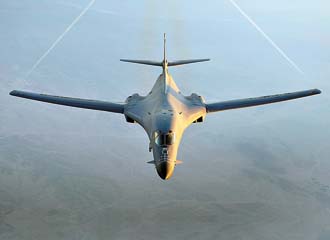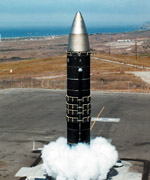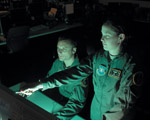Collaboration Enables Strategic Missions
 |
 |
 |
The Integrated Strategic Planning and Analysis Network (ISPAN) is the command and control system for U.S. Strategic Command (STRATCOM). ISPAN was recently enhanced with the Collaborative Information Environment (CIE), a set of information-sharing tools that allow strategic missions to be planned and coordinated across multiple combatant commands. |
A collaborative planning and information-sharing capability is making a key
The Integrated Strategic Planning and Analysis Network (ISPAN) is U.S. Strategic Command’s (STRATCOM’s) system for planning and executing global strategic missions such as nuclear and conventional strikes. ISPAN allows commanders to monitor ongoing situations in real time, make assessments, and devise and support an operation in coordination with regional commands. The system pulls in data from a variety of sources such as space-based and airborne sensor platforms to provide commanders with real-time situational awareness.
When a threat arises, ISPAN generates a range of courses of action with estimates of success, potential collateral damage, required resources and operational time frame. Commanders then can choose one of the mission options. ISPAN is co-located with STRATCOM at Offutt Air Force Base in
ISPAN began installation in 2004 and reached its initial operational capability in January 2009. ISPAN consists of two groups of tools: the Collaborative Information Environment (CIE) and the Mission Planning and Analysis System, which is used for nuclear operations. These applications have been brought online over the past few years. Already in limited use, the CIE is designed to enhance the entire system’s functionality by allowing commanders and planners to share information and to collaborate across commands and operational domains.
According to ISPAN Division Chief Stacy Furcini, the need to expand planning collaboration originated from a January 2009 memorandum by Gen. James E. Cartwright, USMC, vice chairman of the Joint Chiefs of Staff, which made ISPAN the joint course-of-action development tool for the entire U.S. Defense Department. “What that required was a transition from collaborating on just STRATCOM plans to being able to collaborate on plans from multiple COCOMS [combatant commands],” Furcini says. Prior to this requirement, he notes that providing an enterprise planning service was not a key mission task for STRATCOM.
The CIE provides the strategic-level collaboration between multiple combatant commands and other agencies to support STRATCOM planning. “It allows senior leaders to make better decisions as a result of enhanced collaboration,” Furcini shares.
ISPAN CIE provides decision makers with several capabilities. It permits content-wise collaborative contingency planning, collaborative crisis planning, leadership decision support and user training. This training feature provides both traditional learning and nontraditional methods delivered via Web services. ISPAN also features a network-ready infrastructure that can consume and leverage data sources for use in rapid analysis and assessment applications.
Furcini explains that a difference exists between contingency planning used to support an operational plan and time-sensitive planning. Contingency planning is not time constrained and is used to plan for certain types of known scenarios, such as nuclear and conventional strategic strikes. The other, more time-critical type of planning usually has a more specific and detailed goal and may borrow from a contingency plan, but its execution is time constrained, he says.
STRATCOM employs a variety of planners to manage its operations. Furcini describes these individuals as subject matter experts with specializations such as logistics, weapons allocation, intelligence or weather analysis. These specialists use ISPAN as a single-application interface. To support them, the CIE features a number of subject-specific portlets. There are also group portlets that allow all users to track a plan’s development process. Furcini notes that a joint planning doctrine requires specific steps to develop a plan. “It’s the policy end of how we do joint planning in the Defense Department,” he explains. To achieve this goal, his office used the Defense Department’s Joint Publication 5 as a resource and extracted the steps necessary to construct a course of action or plan necessary to inform a commander's decision.
The CIE focuses on joint planning for global strike missions. STRATCOM uses an enterprise database for its various strike missions, explains Cliff Spier, vice president of command and control solutions for Lockheed Martin’s information systems and global services division, which developed ISPAN. Planners have access to this information and produce templates for courses of action. The staffers pull the data from the database and modify it through a series of user interfaces available through the system. For example, if a specific sortie is required, a course-of-action template for a mission will be modified. Because the CIE is a collaborative system, once the plan is posted, he notes, that other planners and staff members from units involved with the mission can make comments and modifications to the plan.
The system is built around a service-oriented architecture and features a software and hardware infrastructure that supports mission applications. ISPAN operates at the secure Internet protocol and Joint Worldwide Intelligence Communications System (JWICS) levels. Spier notes that it is a thin client system that authorized users can access through their Web browsers for situational awareness and collaborative tools.
ISPAN CIE’s collection of portlets allows specialists to collaborate in their areas of expertise. The tool then automatically collects this data and inserts it into a briefing, integrating information into a form that allows a senior decision maker to compare and select a course of action and then take these recommendations to leaders such as the secretary of defense.
Before the CIE, Furcini explains, planners used telephones and e-mail to communicate. These experts then individually put their information into PowerPoint slides that were collated manually into a commander’s presentation. “Once you put that information into a PowerPoint format, that plan is almost immediately stale. Weather continues to change; intelligence updates might continue to come in; there might be impacts to some of the sorties suggested. All of those cannot be captured in a manual PowerPoint presentation unless you have someone there constantly updating it,” he maintains.
Other examples of data assimilation include tracking data from space sources and force tracking information provided by the services. This information is automatically included into the planning process and updated into a document. Furcini notes that this live information feed makes the report immediately relevant to decision makers. “Our strategy is to rely on authoritative data sources to the maximum extent possible and to consume them on a machine-to-machine basis, allowing the participants—whether they are planners or decision makers—to be involved in the construction process at any point in time,” he shares.
In previous applications, mission material had to be assembled before the commander was briefed. Under ISPAN, the commander can monitor the entire process from the beginning. “He can see the portlet content that the intelligence guys are working on,” Furcini says.
The Block 1 portion of the entire ISPAN program, which represents the final operational versions of all of the system’s software tools such as those in the CIE, is scheduled to reach full operational capability in July 2010. Furcini adds that the program will be followed up with future increments. The next phase, Increment 2 milestone B, is scheduled to launch in April 2010. An additional two increments are scheduled for subsequent years.
This incremental approach distinguishes ISPAN from other efforts, Furcini explains. The program features an acquisition strategy built around incremental software deliveries. As STRATCOM pursues collaborative strategies, he notes, the acquisition community can deliver software based on clearer requirements and a better-defined business environment for collaboration. “It allows us to reduce our customer’s risk up front by not having to figure out all of the collaboration details ahead of time,” he says.
This strategy allows the command to perform some collaboration now, within limited parameters. As the process evolves between the combatant commands, more collaborative capabilities will be introduced. The follow-on increments also provide functional content such as updates for global users. This allows the tools to display certain features specifically designed for use by some combatant commands. Furcini notes that his group will conduct any post initial operating capability enhancements required by STRATCOM.
ISPAN originated from an effort to modernize STRATCOM’s legacy planning system for nuclear operations, the Strategic War Planning System (SWPS). Furcini notes that STRATCOM is responsible for planning and conducting strategic nuclear and kinetic operations. He explains that over the decades, the
After 2000, STRATCOM’s operational responsibilities changed to include new missions such as missile defense; command, control, communications, computers and intelligence; and space operations. As the command’s missions changed, its business processes also evolved to require greater levels of collaboration, necessitating the additional modernization of all of the organization’s planning and coordination tools. The current efforts are a part of this ongoing modernization work, Furcini says.
WEB RESOURCES
Lockheed Martin: www.lockheedmartin.com




Comments